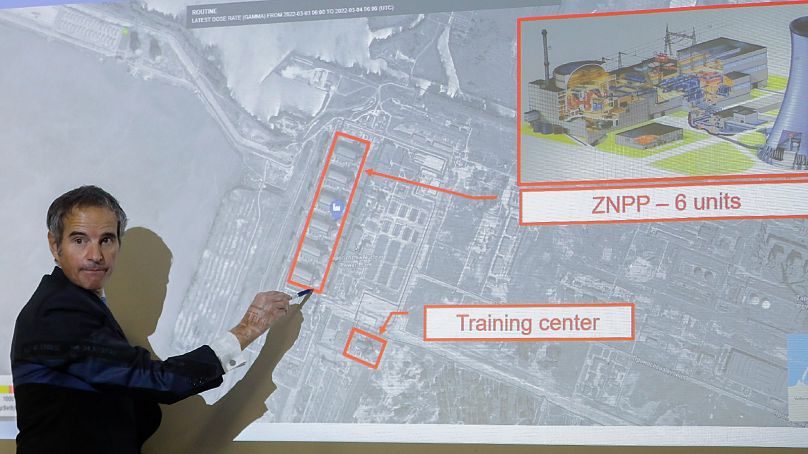Russia's latest attack on a nuclear site in Ukraine sparks alarm in Europe, with fears that the cooling systems at the Zaporizhzhia power plant could be at risk.
Europe's largest nuclear power plant was hit by Russian shelling early Friday, raising fears of a disaster that could affect all of central Europe for decades, like the 1986 Chernobyl meltdown.
Concerns faded after Ukrainian authorities announced that the fire that hit a training centre had been extinguished and that the safety of the reactor unit was not affected.
But even though the Zaporizhzhia nuclear plant is of a different design than Chernobyl and is protected from fire, nuclear safety experts and the International Atomic Energy Agency warn that waging war in and around such facilities presents extreme risks.
One major concern is that if fighting interrupts power supply to the nuclear plant, it would be forced to use less-reliable diesel generators to operate cooling systems.
A failure of those systems could lead to a disaster similar to that of Japan's Fukushima plant, when a massive earthquake and tsunami in 2011 destroyed cooling systems, triggering meltdowns in three reactors.
The consequence of that, said Ukrainian President Volodymyr Zelenskyy, would be widespread and dire.
“If there is an explosion, that's the end for everyone. The end for Europe. The evacuation of Europe,” he said in an emotional speech in the middle of the night, calling on nations to pressure Russia's leadership to end the fighting near the plant.
What happened overnight?
Enerhodar Mayor Dmytro Orlov said a Russian military column had been seen heading toward the nuclear facility and that loud shots were heard in the city. Later on Friday morning, Ukrainian authorities said Russia had taken over the nuclear plant.
Plant spokesman Andriy Tuz told Ukrainian television that shells had fallen directly on the facility and set fire to one of its six reactors.
Initially, firefighters were not able to get near the flames because they were being shot at, he said.
Even ahead of the attack, the director of the U.N. nuclear watchdog, Rafael Grossi, had warned that the IAEA was “gravely concerned” with Russian forces conducting military operations so close nearby.
What could have happened?
The reactor that was hit was offline, but still contains highly radioactive nuclear fuel. Four of the other six reactors have now been taken offline, leaving only one in operation.
The reactors at the plant have thick concrete containment domes, which would have protected them from external fire from tanks and artillery, said Jon Wolfsthal, who served during the Obama administration as the senior director for arms control and nonproliferation at the National Security Council.
But a fire at a nuclear power plant is never a good thing, he said.
“We don't want our nuclear power plants to come under assault, to be on fire, and to not have first responders be able to access them,” he said.
Keeping cooling systems running
Another danger at nuclear facilities are the pools where spent fuel rods are kept to be cooled, which are more vulnerable to shelling and which could cause the release of radioactive material.
Perhaps the biggest issue, however, is the plant's power supply, said Najmedin Meshkati, an engineering professor at the University of Southern California who has studied both the Chernobyl and Fukushima disasters.
The loss of off-site power could force the plant to rely on emergency diesel generators, which are highly unreliable and could fail or run out of fuel, causing a station blackout that would stop the water circulation needed to cool the spent fuel pool, he said.
“That is my big — biggest concern,” he said.
David Fletcher, a University of Sydney professor in its School of Chemical and Biomolecular Engineering, who previously worked at UK Atomic Energy, noted that even shutting down the reactors would not help if the cooling system failed in such a way.
"It was this type of damage that led to the Fukushima accident," he said.
Chernobyl site also a concern
Ukraine is heavily reliant on nuclear energy, with 15 reactors at four stations that provide about half the country's electricity.
Following a conversation with Ukrainian Prime Minister Denys Shmyhal, IAEA Director Grossi appealed to all parties to “refrain from actions” that could put Ukraine's nuclear power plants in danger.
Shmyhal called on western nations to close the skies over the country's nuclear plants, calling it "a question of the security of the whole world".
Ukraine is also home to the former Chernobyl nuclear plant, where radioactivity is still leaking, which was taken by Russian forces in the opening of the invasion after a fierce battle with the Ukrainian national guards protecting the decommissioned facility.
In an appeal to the IAEA for help earlier this week, Ukrainian officials said that Chernobyl staff have been held by the Russian military without rotation and are exhausted.
The IAEA earlier this week appealed to Russia to let the Chernobyl staff "do their job safely and effectively".
Radioactive waste sites also hit
During fighting on the weekend, the Russian fire also hit a radioactive waste disposal facility in Kyiv and a similar facility in Kharkiv.
Both contained low-level waste such as those produced through medical use, and no radioactive release has been reported, but Grossi said the incidents should serve as a warning.
"The two incidents highlight the risk that facilities with radioactive material may suffer damage during the armed conflict, with potentially severe consequences," he said.
Mitsuru Fukuda, a professor at Nihon University in Tokyo and expert on crisis management and security, said the Zaporizhzhia attack raises broader questions for all countries.
"Many of us did not expect a respected country’s military would take such an outrageous step," he said.
"Now that (Russian President Vladimir) Putin has done it, not only Ukraine but the international community, including Japan, should reevaluate the risk of having nuclear plants as potential wartime targets".












